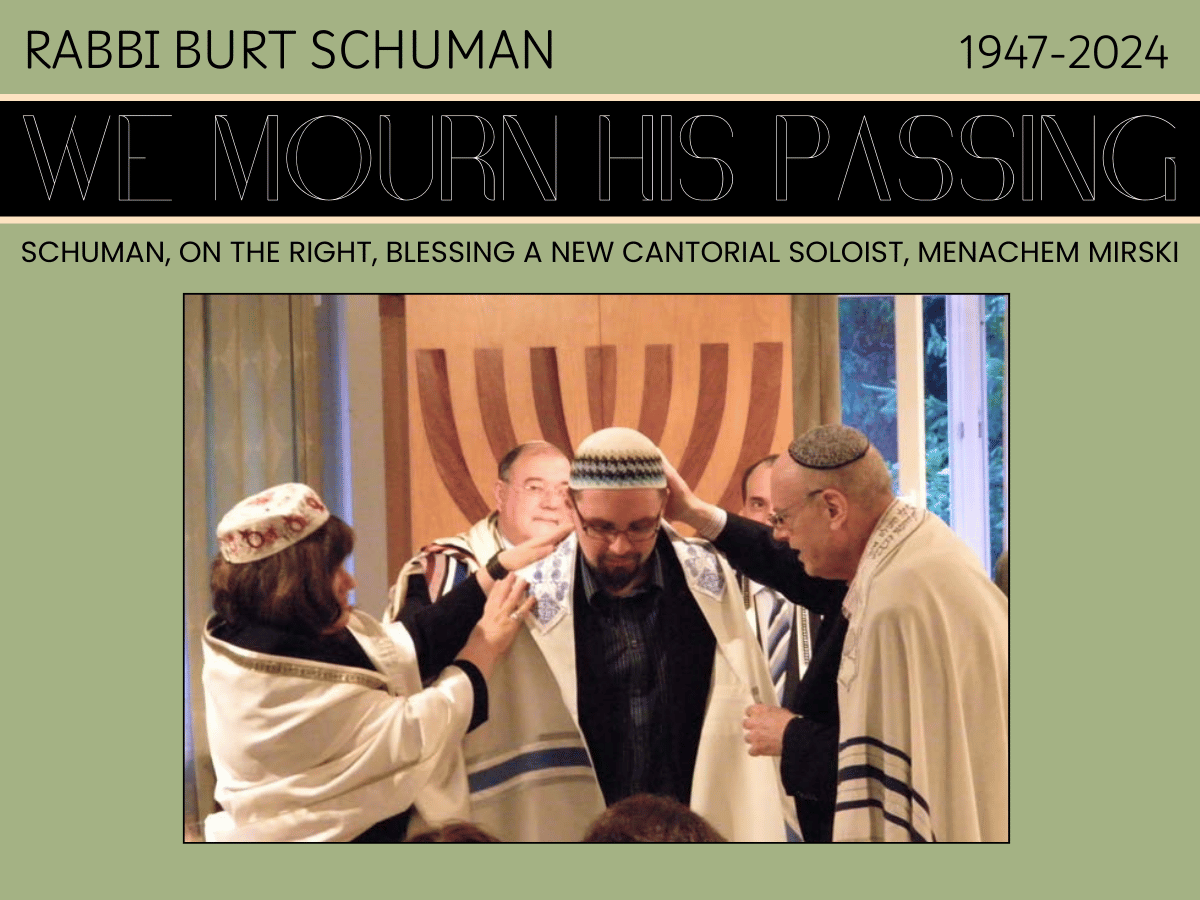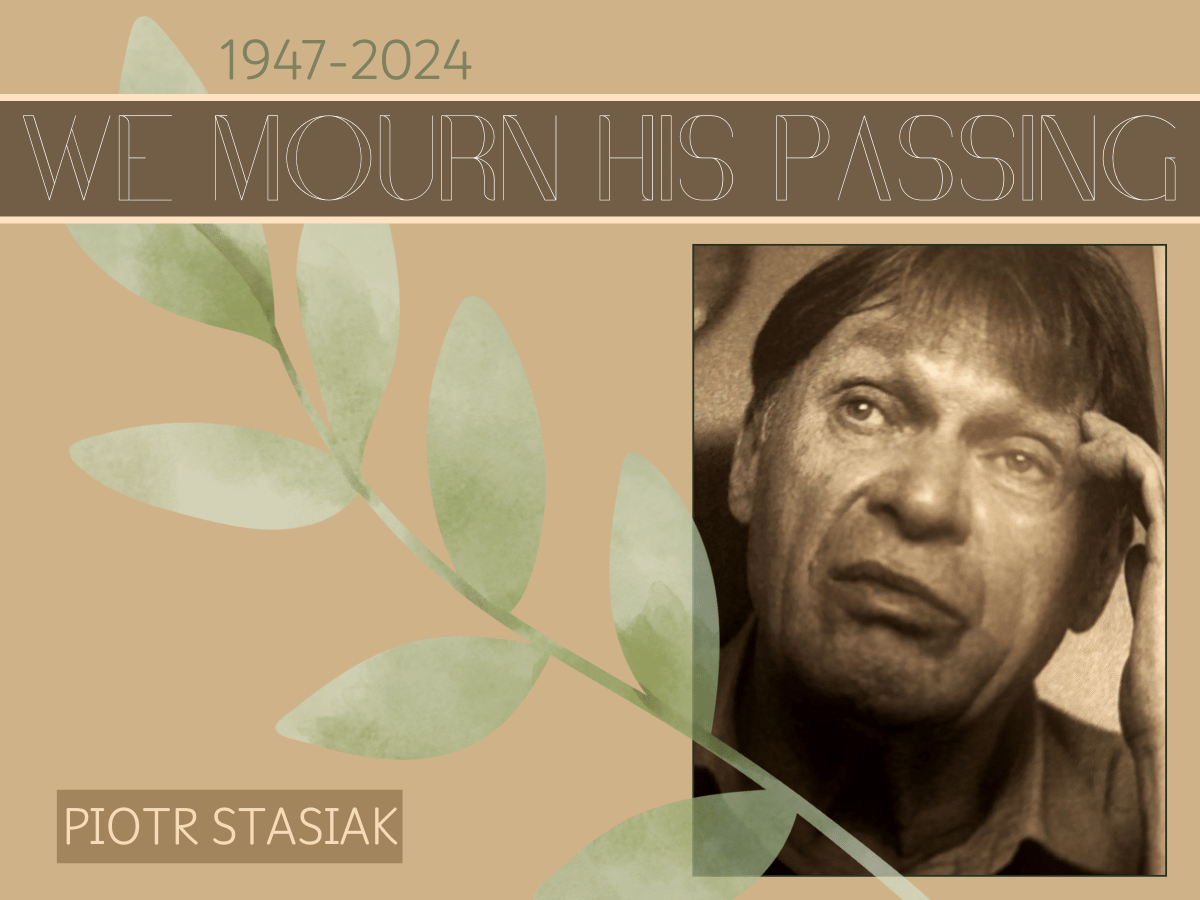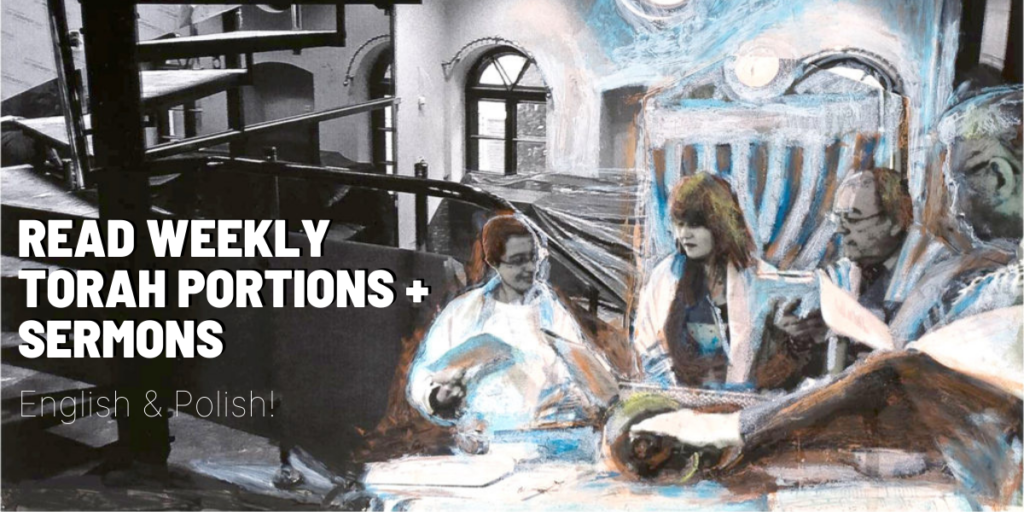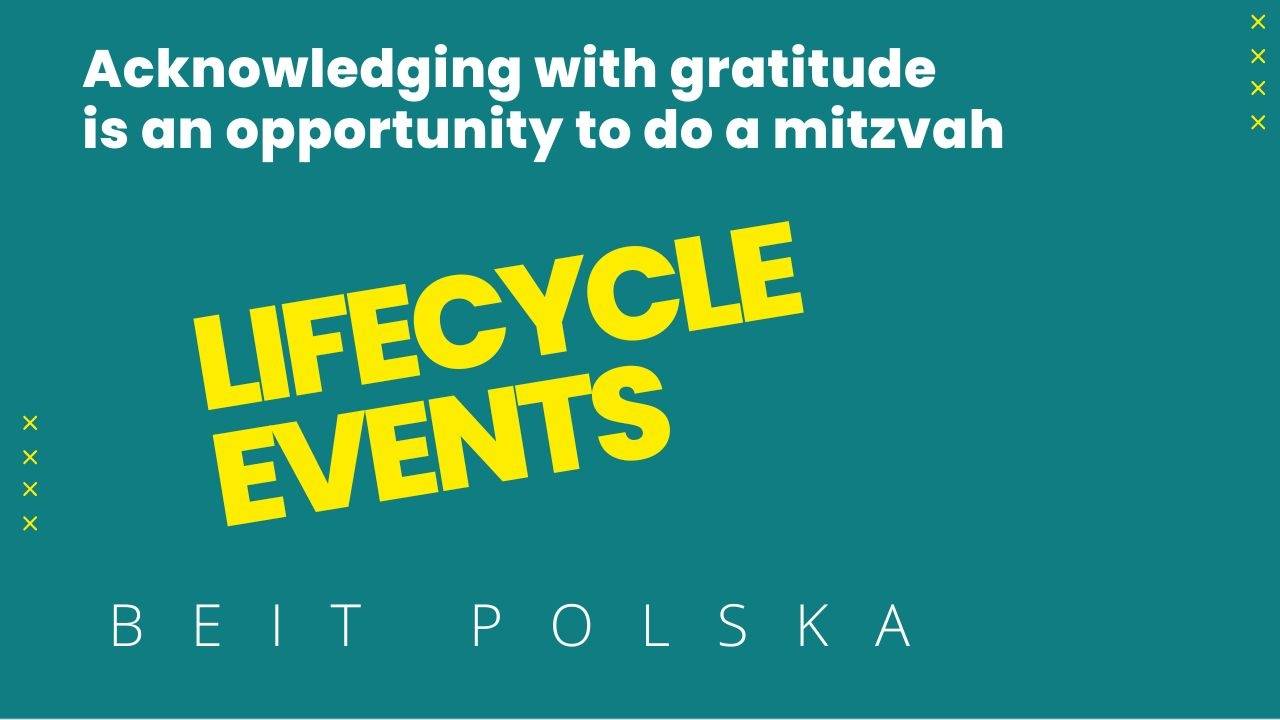
Rabbi Dr Walter Rothschild
SERMON FOR BEIT WARSZAWA
Our portion for this Shabbat comes from the second part of the Book of Shemot, of Exodus – the part which is largely formed of an instruction book for making the ritual objects which God commanded to be made as a consequence of the catastrophic incident of the people worshipping an idol, a golden calf, immediately following the revelation on Mount Sinai (although, confusingly, this is described later.) It became suddenly clear that the Israelites needed more than an abstract concept of God, a cloud or a divine voice or an enigmatic ”I am who I am”; they needed something solid that they could see, they needed something physical they could do.
This is a standard human failing – and I use the word ‘failing’ advisedly for we believe strongly in things we cannot see but feel – such as love, or fear – and yet often we cannot believe in other things unless we have a picture or a model in front of our noses. Where would Christianity – even Protestant Christianity – be without icons and pictures of a nursing mother or a man nailed to two wooden beams? Where would Buddhism be without statues of the Buddha? Although Islam shares the Jewish prohibition on pictures of God there is much Islamic art portraying prophets and heroes. It is interesting how many ultra-Orthodox Jews have no problem with collecting fantasy portraits of bearded and turbaned ancient rabbis, or pictures of priests in their robes and headgear standing at the altar, or even models of the long-destroyed Temple. Of course we also know what an impact a tall stone wall, or a rather dusty, crowded city, can have upon the feelings of otherwise-rational people. People are prepared to die so that they can rescue a flag or a banner from being captured…. giving their lives for a square of coloured cloth, because it symbolises for them so much more…..
This is an essential element of almost all religions. Those who do not believe, do not understand the power of this symbolism – or else they try to replace it with something else.
Our sidra is therefore embedded in a series of sidrot which, although rather mixed-up chronologically (to the extent that Rashi commented that one cannot understand the sequence at all – ”Eyn Mukdam uMe’uchar baTorah” – ”There is no Before and After in the Torah narrative” – are occupied with detailed ritual instructions. (As I have already hinted, one major problem in this respect is that the incident with the Golden Calf is actually introduced in Chapter 32, in the NEXT sidra!) At the very end of the sidra ‘Yitro’ in Chapter 20, directly following the ”Asseret HaDibrot”, the Ten Words or Ten Commandments, God commands Moses that the Israelites should build only a very simple altar out of earth or at most use uncut, natural stones, they should have no silver or golden idols of gods, and they should take care not to make the altar too high so that they might reveal immodest and embarrassing sights when climbing up to them. One gets the feeling that whoever wrote that had indeed seen Egyptian priests in mini-robes climbing the steps and knew what he was talking about. All is to be modest and natural and – yes – essentially abstract.
Then comes the sidra ‘Mishpatim’, which concentrates initially on civil laws, laws of damages and property (including human property, slaves), accidental damage and loss and seduction. But then in 22:17-19 we are abruptly told: Don’t let a magician or wizard stay alive; anyone who has sex with an animal, should die; anyone who brings a sacrifice to any other god – should come under ”Cherem”. Following which alarming prohibitions and punishments the text for the rest of Chapter 22 and all of 23 reverts to issues of social justice. But suddenly in Chapter 24 God calls Moses to come to the Mountain with his brother and his two eldest nephews (not the other two!) and seventy ‘Elders’ and Moses builds an altar with representations of the Twelve Tribes – the Shivtei Yisrael, mentioned here as Tribes for the first time – and this delegation climbs the mountain and sees God…. and there is a festive meal – and THEN God tells Moses to come to the summit to receive the stone tablets with the revelation. So he does and is hidden in a cloud for forty days.
At which point the next Sidra ‘Teruma’ starts (Chapter 25) and here God starts with ritual instructions, for offerings, for a mobile holy structure that is formed of a box that can be carried on poles, all from acacia wood and pure gold, then in Chapters 26 and 27 complex and detailed instructions for the inner furnishings, the curtains and the carpets, also the altar with its copper covering, almost like one of those magazines for internal decorations.
So our sidra Tetzaveh starts with the instructions for the lighting, then in Chapter 28 for the appointment and robes of the Priests (Aharon and, this time, all four of his sons), then in Chapter 29 we start describing the ordination and formal robing of the priests and the sacrifices, including the daily routine sacrifices which are so to speak the basis for the ritual – the altar will be in continuous operation, the lamps will burn, the fire will glow the whole time, whether or not individuals bring their own sacrifices as well.
I have spent a lot of time giving this context because these are in the narrative very significant days and weeks for the Israelites; they have ”left” Egypt – the word ”left” is here a euphemism because they were both pushed and dragged out at the same time – they left involuntarily – and they were totally lost and disorientated in a new environment, a desert, not knowing where they were heading or what was really going on, who was leading them and why. (Moses was, after all, a stranger who had turned up out of nowhere, he was not one of them, not someone whom they knew or trusted, not someone whom they had chosen to be their leader.) We who have our printed Bibles and know how the story continues have an enormous advantage over the poor former slaves who find themselves liberated from all that they knew – their homes, their work, hard though it might have been – and cast out into an empty space. The Rabbis traditionally spoke very dismissively of the ‘Dor HaMidbar‘, the generation of the Wilderness, who were so afraid, too afraid to move forward when told to, but I believe that those of us who have experienced either directly or indirectly some of the mass population movements and expulsions of the last century, who know the family histories, should have more empathy for them. After several hundred years of existence in Egypt – an existence made bitter by hard labour and State persecution, but at least they knew where they were and they had food and water and homes – now they are in the middle of a wilderness and of course, once the first shock is over, they clamour for water, for food, for shelter, for safety, for direction. Soon they will start to look back with nostalgia on the former days, back in Egypt….. This is normal for almost all refugees and deportees. Home remains Home, even if someone has stolen it from you and thrown you out.
How do you build a nation out of a rabble? How do you introduce a radical new State religion to replace the multitude of old customs and superstitions and scraps of Egyptian religion that the people had had until now? How do you create a new centre for worship, a new cadre of priests, a new range of sacrifices to fill the gap left by the loss of all the old certainties? Egypt had been a place where religion was taken very seriously, a place filled with Temples and Tombs, with holy statues and people who – much like those who now choose to be cryogenically frozen – were planning to come back to life at the right time and, in the meantime, were kept mummified in their cases. The rulers expected to continue ruling even after they had died, and expected to be provided with their furniture and their servants so that they could continue in comfort. They were static, not dynamic. But now the people of Israel will have to make do with a mobile sanctuary and no fixed place to stay until they reach a land vaguely referred to as ”promised to your ancestors”.
What is noticeable and sometimes frustrating is how the Torah text ranges abruptly between broad, emphatic general principles – ”Love God! Respect your Parents! Keep the Sabbath!” and then devotes itself obsessively to tiny obscure details regarding the clothing of the priests or the amount of oil to be mixed with the flour and precisely how many lambs are required for a specific ritual. Is it all really important? Would God get angry if one sacrificed only one ram and not two in Chapter 29 verse 1? Would the whole system fall apart if one of the priests forgot a part of his underwear in Chapter 28 verse 42? Or if the incense was missing one ingredient in Chapter 30 verse 9?
Well – yes and no. It does not take long before two of the priests, inexperienced and maybe over-confident, are burned up because they make a mistake. It appears from the text to be more an accident than a punishment but even so, it demonstrates that these regulations are to be taken seriously and followed carefully. And the other main function is that the people should not feel so alone. Rather than looking backwards for divine help they should look upwards; rather than thinking of the Gods back in Egypt they should be constantly aware of the God in the midst of their camp. They will still have a divine partner with whom to speak, should they be in fear, should they have questions, should they have specific wishes, should they feel grateful or guilty. These people have never read the Book of Genesis, they know little of earlier stories and generations, even if they have brought Joseph’s mummified body with them. God demands a lot of them and, psychologically, they are not yet ready for the next leap forward. It is one thing to shout ”Na’asseh veNishmah!” – ”We will do it, we will listen!” – but quite another to head through the Sinai desert to a country which, their scouts tell them, is well-fortified and inhabited by giants.
These are people who had been slaves all their lives, had had no military training, had beaten back one nomadic tribe of Amalekites but otherwise had no experience. All their lives they had been told what to do, and now they were being told to trust an invisible God, and to make decisions!
So this week’s sidra is a part of this important transition phase in the history of the People of Israel. After the twin melodramas of the crossing of the Sea and the voice that spoke from a cloud over a mountain, comes the anti-climax and the need to establish new routines, new rituals.
And we? Are we any better? Are we able to pray to God without special decorated buildings and special professional ordained staff in complicated robes? Are we prepared to move forward into an unknown future, are we able to trust, are we able to hope?
We can read the old texts and see how it was done then, but how do we apply these lessons to our own lives and our own times? Can we separate the broad principles of morality and humanity from an almost neurotic obsession with ritual and detail? A few weeks ago I attended a synagogue where women, kept in a separate cage, reached their arms out towards the Sefer Torah as the men carried it around, then held their hands to their mouths and kissed them. This was the closest they could get to this mysterious, invisible God whose presence they felt and yet they could not reach. Rather than sitting with an open Chumash and reading the Torah text in whatever language, original or translation, they needed, they yearned instead for non-physical contact with some invisible rays spreading from the tightly-rolled, closed and covered parchment. I watched with sadness and felt that this was somehow an important symbol of the need to identify with the Sefer rather than the Torah. I know of people who speak with authority about the exact way Tefillin should be worn and where the knots should be, but I wonder when they last read the texts which are incorporated within.
The Sidrot that follow will continue this theme of building the ritual infrastructure and the book Vayikra will also devote much attention to its use, but it will be left to the prophets, much later, to remind us that ritual alone is not enough, that temples can be lost and destroyed – and deservedly so – if religion becomes merely a matter of ritual habit divorced from inner content. This is a challenge that faces all religions, all the time. We are no exception.
Shabbat Shalom.
Rabbi Dr. Walter Rothschild.
















Leave a Reply